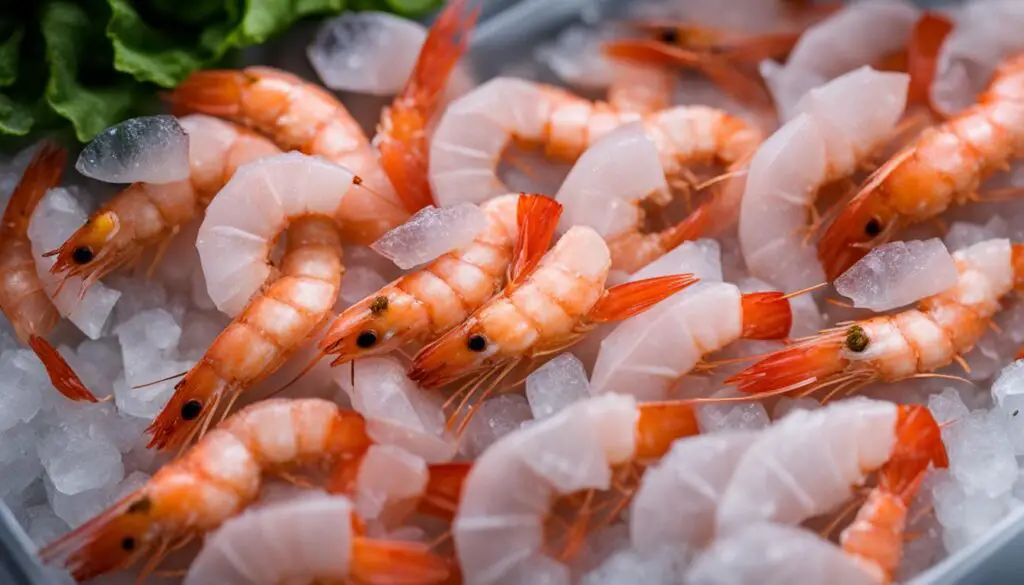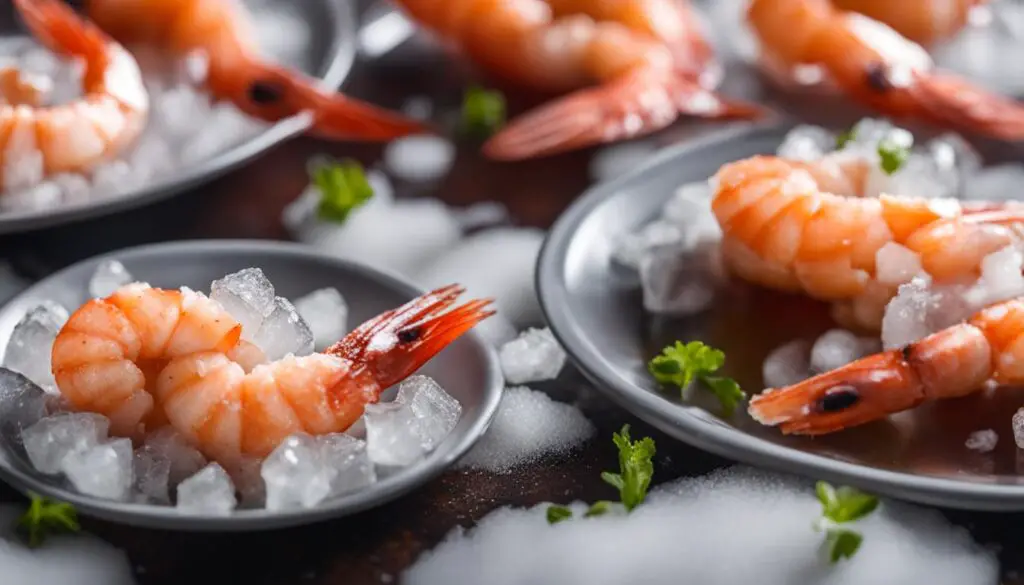When it comes to thawing shrimp, it’s important to do it safely to preserve its texture and flavor. One of the best ways to thaw shrimp is by transferring it from the freezer to the fridge the day before you plan to cook it. This method ensures a slow, gradual thawing process that maintains the shrimp’s quality and freshness.
So, how long can shrimp thaw in the fridge? Frozen shrimp needs at least 12 hours to thaw completely in the refrigerator. During this time, the exterior of the shrimp will become translucent, and the shrimp itself will become pliable without any stiffness from interior ice. Once thawed, it’s important to place the shrimp on a paper-towel lined baking tray or platter to remove any excess moisture and prevent sogginess during cooking.
Key Takeaways:
- Thawing shrimp in the fridge is the best and safest method for preserving its texture and flavor.
- Frozen shrimp needs at least 12 hours to thaw completely in the refrigerator.
- Thawed shrimp should be placed on a paper-towel lined baking tray or platter to remove excess moisture.
- The slow, gradual thawing process in the fridge helps maintain the quality and freshness of the shrimp.
- By following proper thawing techniques, you can ensure safe and delicious shrimp for your meals.
The Most Surprising Way to Cook Shrimp
When time is of the essence and you need to thaw frozen shrimp quickly, the cold water method is your go-to solution. This surprising technique allows you to have perfectly thawed shrimp in a fraction of the time it takes when using the refrigerator method.
To begin, fill a large bowl with ice-cold water. Make sure the water is cold enough to maintain a safe temperature throughout the thawing process. Place the frozen shrimp in a zip-top bag, ensuring it is sealed securely to prevent water from seeping in. Submerge the bag in the cold water, making sure it is fully covered. For optimal results, use a heavy object, such as a plate or bowl, to weigh down the bag and keep it submerged.
Now, here comes the waiting game. Let the shrimp sit in the cold water for 20 to 30 minutes, allowing the icy shells to gradually thaw. During this time, the cold water gently works its magic, coaxing the shrimp back to its tender, succulent state.
Alternatively, if you need to thaw the shrimp right away, you can bypass the bag and place them directly in the cold water. Stirring the water every few minutes helps to break up any frozen clumps and ensures even thawing.
After the shrimp have reached their desired level of thawing, remove them from the cold water and pat them dry with a paper towel. This step is crucial to remove any excess moisture, which could lead to unwanted sogginess when cooking.
Now that you have perfectly thawed shrimp, you are ready to whip up an array of delectable seafood dishes. Whether you’re grilling, frying, or sautéing, your thawed shrimp will cook evenly and deliver exceptional flavor and texture.
How to Reheat Shrimp
If you have thawed shrimp but don’t plan to cook or eat them immediately, it is important to know how to properly reheat them to ensure food safety and maintain their quality. Here are some guidelines for reheating shrimp:
-
No Room Temperature: Thawed shrimp should never be left at room temperature. This can create the perfect environment for bacterial growth, leading to foodborne illnesses. Always store thawed shrimp in the refrigerator until ready to reheat.
-
Avoid Microwaving: While it may be tempting to quickly defrost shrimp in the microwave, it is not recommended for reheating. Microwaving frozen shrimp can result in a chewy texture and partial cooking, compromising the taste and quality. Instead, opt for other cooking methods.
-
Safe Shelf Life: Thawed shrimp can be stored in the refrigerator for one to two days before cooking. However, it is important to note that the shelf life of thawed shrimp should not exceed 48 hours. This ensures that the shrimp remains fresh and safe to consume.
“Proper reheating methods are crucial to maintain the taste and quality of thawed shrimp. Here are some guidelines to follow to ensure food safety and enjoyment.”
When reheating shrimp, you can choose from various cooking methods such as sautéing, grilling, baking, or even adding them to soups and pasta dishes. Just make sure to heat them until they are warmed through to an internal temperature of 145°F (63°C) to ensure food safety. Remember, overcooking can result in tough and rubbery shrimp, so be mindful of the cooking time.
To enhance the flavors, you can season the shrimp with herbs, spices, or marinades before reheating. This will help infuse the shrimp with delicious flavors while maintaining their tender texture.
Reheating Shrimp Cooking Times:
| Cooking Method | Cooking Time |
|---|---|
| Sautéing | 2-3 minutes |
| Grilling | 3-4 minutes per side |
| Baking | 8-10 minutes at 375°F (190°C) |
By following these guidelines and using proper reheating methods, you can enjoy delicious and safely reheated shrimp without compromising taste or quality.
The Right Way to Peel and Devein Shrimp
When it comes to thawing shrimp, it is essential to follow safe methods to ensure food safety and prevent the risk of foodborne illnesses. Thawing shrimp in the refrigerator overnight is the best and safest method, allowing for a gradual thawing process without compromising the quality of the shrimp.
Tip 1: Place the frozen shrimp in a colander and set it over a bowl to catch any drips. This prevents the shrimp from sitting in excess moisture, which can lead to a soggy texture.
Tip 2: Another effective method for thawing shrimp is to use a sealed zip-top bag and submerge it in cold water. Make sure the bag is fully submerged, and change the water every 30 minutes to ensure it remains cold.
Tip 3: For those who need to thaw shrimp quickly, placing them directly in a bowl of cold water can help expedite the process. However, keep in mind that this method may result in the shrimp absorbing excess water, affecting its texture.
Once the shrimp is fully thawed, it is ready to be peeled and deveined. Start by removing the shell, gently peeling it off from the shrimp’s body. Then, using a small knife or shrimp deveiner, make a shallow incision along the back of the shrimp. Remove the black vein running down the back by gently lifting it out or rinsing it under cold water.
Thawing shrimp in the refrigerator and following these safe methods not only ensures that the shrimp defrosts properly but also helps maintain its optimal texture and flavor. Now, let’s learn how to reheat shrimp in the next section.

How to Reheat Shrimp
Thawing shrimp properly is essential for maintaining its texture and quality. When it comes to reheating thawed shrimp, there are a few important things to consider.
1. Safe Thawing Methods
The ideal way to thaw shrimp is to do it gradually in the refrigerator overnight. This method allows for a controlled thawing process, ensuring the shrimp remains safe to eat. It is recommended to allow at least 12 hours for the shrimp to fully thaw in the fridge.
If you’re short on time and need to thaw the shrimp more quickly, you can use the cold water method. Place the frozen shrimp in a sealed zip-top bag and submerge it in a bowl of cold water. Change the water every 30 minutes until the shrimp is thawed. However, keep in mind that this method may result in the shrimp absorbing excess moisture.
2. Storage and Shelf Life
Once the shrimp has been properly thawed, it can be stored in the refrigerator for up to 48 hours before cooking. It’s crucial to check the freshness of the shrimp before consuming it, as thawing only extends the shelf life for a limited period.
3. Reheating Methods
When reheating shrimp, it’s important to use proper cooking methods to ensure food safety. Avoid leaving thawed shrimp at room temperature for extended periods, as this can promote bacterial growth. Likewise, microwaving frozen shrimp to thaw should be avoided, as it can result in a chewy texture and partial cooking.
If you want to warm up the shrimp, consider using methods like sautéing, grilling, or baking. These techniques help retain the shrimp’s texture and flavor without compromising its quality.
By following these safe thawing and reheating methods, you can enjoy delicious, tender, and flavorful shrimp with confidence.

Conclusion
Thawing shrimp in the fridge is the best way to ensure safe and high-quality thawing. It is recommended to give the shrimp ample time to thaw by placing it in the fridge overnight, allowing at least 12 hours for complete thawing. This gradual thawing process helps maintain the texture and flavor of the shrimp, resulting in a better culinary experience.
If you’re in a hurry and need to thaw shrimp quickly, the cold water method can be used. However, it’s important to note that this method may result in excess moisture which can affect the final texture of the shrimp. Make sure to submerge the frozen shrimp in a zip-top bag in cold water and allow it to sit for 20 to 30 minutes until fully thawed.
When reheating shrimp, it is crucial to follow proper cooking methods to ensure food safety. Thawed shrimp should be consumed within 48 hours of thawing to maintain its freshness. Avoid leaving thawed shrimp at room temperature for extended periods as it can promote bacterial growth. Additionally, microwaving frozen shrimp for thawing should be avoided as it can lead to a chewy texture and partial cooking.
Remember, the key to delicious and safe shrimp is to thaw it properly. By following the recommended thawing times and methods, you can enjoy perfectly thawed shrimp that is ready to be cooked and savored.
FAQ
How long does it take for shrimp to thaw in the fridge?
Shrimp needs at least 12 hours to thaw in the fridge. The shrimp is considered thawed when the exterior becomes translucent and the shrimp is pliable without any stiffness from interior ice.
What is the best way to thaw shrimp in the fridge?
The best way to thaw shrimp in the fridge is to transfer it from the freezer to the fridge the day before you plan to cook it. This allows for gradual and safe thawing and helps to maintain the texture and flavor of the shrimp.
Can I thaw shrimp in cold water?
Yes, if you need to thaw shrimp quickly, you can use the cold water method. Fill a large bowl with cold water and place the frozen shrimp in a zip-top bag. Submerge the bag in the cold water and let it sit for 20 to 30 minutes, until the shrimp are fully thawed.
How long can I store thawed shrimp in the fridge?
Thawed shrimp can be stored in the fridge for one to two days before cooking. It is important not to keep thawed shrimp in the fridge for more than 48 hours.
Can I thaw shrimp at room temperature?
No, shrimp should not be left at room temperature to thaw as it can encourage bacterial growth. Thawing shrimp in the refrigerator overnight or using the cold water method are the recommended safe methods.
Can I use the microwave to thaw shrimp?
It is not recommended to thaw shrimp in the microwave as it can result in a chewy texture and partial cooking. It is best to use the refrigerator or cold water method for safe thawing.

